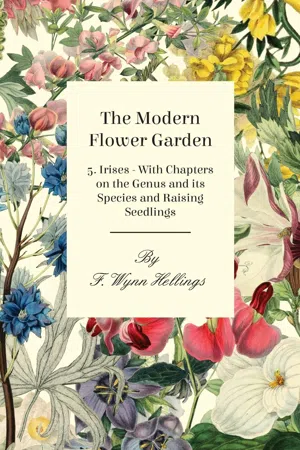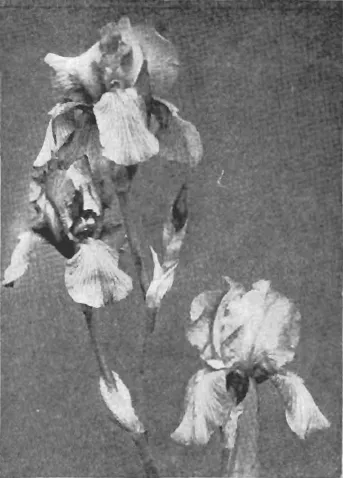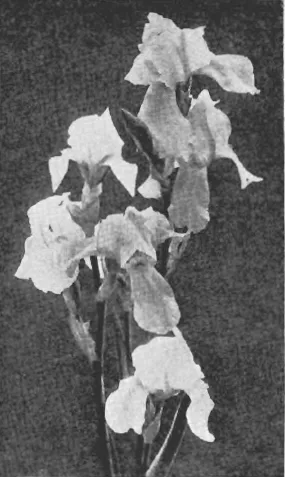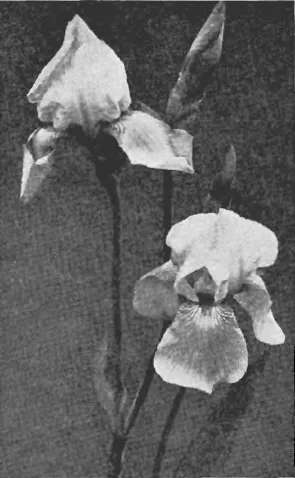![]()
CHAPTER II
The Bearded Irises
We will deal first with the sub-division of the Pogoniris section which comprises those bearded irises with stems not usually branched, bearing a terminal head of one, two or three flowers. I. pumila and I. chamæiris, in one or another colour and form, are fairly extensively grown in this country, although, typically of our English ways, the most widely grown are the sorts of I. chamæiris under the name of “pumila”. I. pumila is easily distinguished from I. chamæiris by being almost, if not entirely, stemless and exhibiting a perianth tube 2 in. or 3 in. long, while the chamæiris stem may be anything from 2 in. to 6 in. and at least as long as the tube of the flower. Moreover, I. pumila loses its foliage in the winter while I. chamæiris retains its leaves and makes foliage growth all the time. There are further botanical differences which need not be gone into here. Both II. pumila and chamæiris require the good, loamy soil which suits the tall bearded flags, and they make satisfactory rock garden plants, provided the site is not too shady or damp. The winter foliage habit of I. chamæiris makes it a satisfactory edging plant, and in such a position profuseness of flower may be looked for with confidence.
So far as I know, a satisfactory definition of the popular name “bearded flag irises” has never yet been given; but the term is well understood as applying to the types germanica, pallida, variegata, neglecta, Ricardi, &c., and their almost innumerable hybrids. These are the irises which command most attention, equally by the small amateur and by the large-scale gardener, and perhaps rightly so. Matched in their beauty by the oncocycli, regelias, ochroleuca, spuria hybrids and the Florida species, they are easier in culture and infinitely varied in their gorgeous raiment. Given full sun, adequate drainage, the scientific proportion of lime in the soil and a simple routine of clean culture, the bearded flag irises of the small amateur will equal in glory those of the experts and the wealthy.
PROPAGATION AND PLANTING
Propagation may be either by seed or by division of the rhizomes. The latter is best carried out immediately after flowering, but it must always be borne in mind that there is no really dormant period for these irises during spring and summer—major root production is continuous—and in autumn all the plant’s energy is needed for the development of feeding rootlets, preparing for winter’s hardship and spring’s ebullience of growth. The advantage of June over August is that there are no long new roots to be damaged and experience has shown that planting at that time gives the best chance of a good flowering season to follow, a disadvantage being that the divided rhizome, having little or no roots, is sometimes difficult to anchor securely in the soil without setting it too deeply for its welfare. The last three weeks in July should be avoided because the rhizome is then forming its flower buds—fifty per cent of irises moved at this time of the year fail to flower in the following season. If planting be not done in June or August it is best to leave the plant undisturbed while it is in the full tide of growth and wait till the last week in September or the first in October. Then the soil is still warm and root action, after three months at full speed, is beginning to decrease in rate. If planting is perforce postponed till the new year, then February is the best month for the work, suitable open conditions being watched for and utilized. A February planting stands a good chance of flowering the same year but alas! too often it will register a miss the year after that, as the plants will be suffering from the strain of establishing themselves and producing flowers in a period of three or four months, instead of ten or eleven months like the summer-planted rhizome.
Perfect drainage is so important that if there is the slightest doubt about securing it the beds should be raised above the level of the surrounding paths.
The most suitable soil is a loam on the heavy side. If it has been well manured with horse dung and a crop of potatoes taken from it so much the better. When the eagerly questing roots of the irises reach the enriched soil they will revel in it and, the manure being partly spent, no evil consequences will follow, but on no account plant in soil newly manured and refrain too from top-dressing with manure, an evil practice which is still recommended by some. Everything being ready—plan of planting, rhizomes, labels, bag of superphosphate of lime, knife, &c.—spread a layer of super. over a convenient-sized area in quantity sufficient to whiten the soil—and set to work. If space will allow, give each rhizome 9 in. all round it in which to develop and then the bed need not be replanted for three or four years. If, however, space be limited and less room can be given, a keen watch must be kept after the second year for overcrowding. The sight of rhizomes climbing all over one another is an urgent call for replanting—the rhizome which has to force its protracted and unwilling way along the backs of its brothers with scarcely a chance to put a root into the soil and proclaim its capacity for independent existence is not going to give rise to a strong plant with a normal meed of flower.
Set each rhizome as firmly as possible close to the top of the soil—almost on the top—but if the absence of long roots or the smallness of the rhizomes necessitates putting it somewhat deeper there is no need for anxiety, the tendency of the rhizome being to lift itself up towards the sun to receive the roasting in which it rejoices. If the weather be droughty it may be advisable to water-in the young plants and perhaps give one or two waterings subsequently, but, generally speaking, watering may be ignored. The period of three or four years given for the retention of a planting is the maximum. According to some authorities it has been found advisable to divide and replant Dominion derivatives and some other lusty-growing varieties every two years.
Winter work is confined to peeling off the dead leaves, which will come away easily from the rhizome when ready, and keeping the beds clean. Here it may be noted that it has long been customary to condemn cutting of the living leaves as highly undesirable, but opinion is now working in the opposite direction. Several expert growers are making a practice of cutting down the leaves half-way at the close of the flowering season, in order that the rhizome may be certain to get the full benefit of sunshine. However, there is not yet sufficient evidence to justify a universal recommendation of the practice, which certainly does not enhance the beauty of the garden.
In dealing with a somewhat damp and heavy soil in one garden in Surrey, where there was a tendency to soft rot and the growth of moss all over the beds in winter, I adopted a treatment which had beneficial results. In the latter half of December after peeling off dead leaves and clearing away the moss, sulphur was sprinkled freely over the beds with a view to combating the rot. Then, in January, the beds were overlaid with powdered charcoal, primarily to counteract the effect of the marked dampness of the soil. The sulphur dressing is recommended for all, but there would be no need for the charcoal on warm light soils.
No further attention is necessary prior to flowering, although good may ensue from a top-dressing of superphosphate of lime, an ounce or two to the square yard, at flowering time. This dressing must not be given the first year after planting if superphosphate is used in planting as recommended above.
Romance (Murrell) satiny rosy-bronze suffused lilac and blue
White Knight (Saunders) of only medium size, but a pure white self of splendid shape and substance
John Waterer (Waterer) Standards silvery blue, falls pale lavender
To stately elegance and beauty of form the bearded irises add wonderful colour harmonies
VARIETIES
As to varieties of bearded flag irises, a large number of those offered for sale are either inherently poor o...



